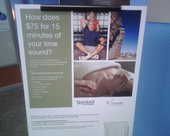
UCSF wellness incentive
The Right Way and the Wrong Way to Promote an Employee Wellness Incentive
 This poster caught my eye while I was on my way to swim at the UCSF Fitness Center. Initially, I thought it was targeted at me but on closer inspection, and with a little bit of dismay, I realized it is aimed at the staff of UCSF—who hopefully are enjoying the fitness center as much as I do.
This poster caught my eye while I was on my way to swim at the UCSF Fitness Center. Initially, I thought it was targeted at me but on closer inspection, and with a little bit of dismay, I realized it is aimed at the staff of UCSF—who hopefully are enjoying the fitness center as much as I do.
This poster is a perfect example of well-executed employee wellness incentive and communication for a health risk assessment (also called a health risk questionnaire). “How does $75 for 15 minutes of your time sound?” Sounds good to me! It follows: “Complete the online StayWell health assessment and receive a $75 gift certificate valid at the UCSF Fitness and Recreation Centers.” It then details how to access the survey and how you can use the gift certificate (like massages, classes and personal training).
Why this poster—and the incentive—work:
- The incentive is a high enough dollar value to entice employees
- It can be used on services that are relevant to health and wellness
- The poster outlines the program clearly
- And, it’s clear that it is an anonymous and voluntary program
With a little investigation, I found the HR announcement that goes with this poster online. Unfortunately, it is an example of what not to do when communicating a program like this. It is all big big figures that individuals can’t comprehend and the best part of the deal—the $75 incentive—is buried below the less-relevant data. It says:
Did you know?
- In 2005, 133 million people, almost one half of all Americans lived with at least one chronic disease.
- Medical care costs of people with chronic diseases account for more than 75% of the nation’s $2 trillion medical care costs.
- The estimated direct/indirect costs associated with smoking exceed $193 billion annually.
- In 2008, the cost of heart disease and stroke in the US is projected to be $445 billion.
- In 2000, the estimated total cost of obesity was nearly $117 billion.
- Chronic diseases account for 70% of all deaths in the US.
While interesting, none of that data is going to inspire or motivate me to get off the couch—or to take an online assessment. Wellness communication should stick to the personal perspective for the best results. Employees connect with what wellness means to them and their families. They don’t connect with figures in the millions or billions.
Work with Us
We partner with organizations that value their people first. Let’s talk.

Jennifer Benz, SVP Communications Leader, has been on the leading edge of employee benefits for more than 20 years and is an influential voice in the employee benefits industry.
